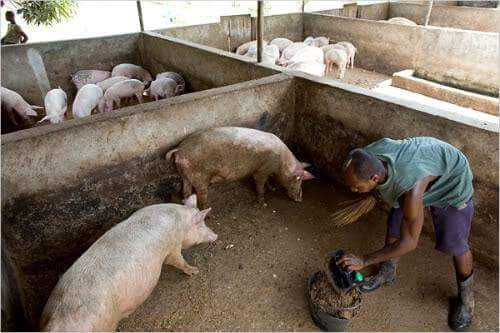A brief history of pig farming in Kenya

The pig industry started with the first importation of pigs from the Seychelles in 1904 then from England in 1905 where the Berkshire and Large Black were brought into the country. The settlers aimed at using excess milk and cereals that they were producing. As the pig became popular, Uplands Bacon Factory was started in 1906. The pigs at that time were regarded as grazing animals and were not kept in enclosures. This led to a serious outbreak of African swine fever in 1907 which wiped out 90% of the pig population. Following the big loss farmers lost interest in pig production and it was not until 1909 that the industry picked up again. This was following the Upland Bacon Factory tightening upon management standards and quality of pigs going to the factory.
The risk of another outbreak of swine fever had not been reduced. The new quality standards could not be met by all farmers and as a result many farmers ended up with no market for their pigs.
The Pig Industry however continued to grow and in 1917, 13,800 kg of pig meat was produced. At the end of the First World War, Pig Producers Association was formed and scientific breeding was started. By 1923 there were 12,100 pigs in the country.
In 1924 there was overproduction and this led to farmers reducing their stock which continued until 1926. After that the Pig Industry saw a gradual improvement but the fear of overproduction still remained in farmers’ minds. In 1931 locust invasion caused shortage of feedstuff resulting in a reduction of pig population. Due to improved pigs through the use of Large White breeding stock the Pig Industry picked up again, there was a marked decrease in the incidence of Swine Fever outbreak with the last one occurring in 1936. The paddocking rules were not however formed until 1951. The Pig Industry continued to grow and by 1958 the pig production reached an all time record of 90,000 pigs slaughtered by the factory. This production had not been planned for and therefore Uplands Bacon Factory faced a financial crisis and the government gave the factory financial assistance. By this time the industry was in the hands of European producers and Uplands Bacon Factory was the only organized market outlet. The Pig Producers Association was dissolved in 1959 and Uplands Factory became a parastatal
In 1964 indigenous Africans started producing pigs. The Pig Industry expanded into small holder areas mainly in Central province such as Nyeri, Kiambu, Nakuru and Murang’a. In 1972 Uplands Bacon Factory became a large scale factory with government support so that by 1977/1978 Nyeri District alone supplied 33.4% of pigs slaughtered by Uplands Factory.
Although Uplands Bacon Factory had a capacity of 2000 pigs per week or 100,000 per year their intake was running at about 40% (i.e. not at full capacity). The reason for this was cited as inadequate pigs in the country due to:-
- Inadequate supply of reasonably priced cereals
- Lack of extension staff of the caliber that can provide necessary advice and guidance to farmers
- Pig feeds are too expensive and are not readily available to small holders. There was therefore a need to sort out feed problems once and for all.
- There was inadequate supply of good breeding stock at reasonable prices.
- There was a constant threat of foot and mouth disease which affect exportation.
- Unfair competition given to Uplands Bacon Factory by other pig meat dealers e.g. East African Meat Products and Nairobi Airport Services (NAS)
In 1986 the Uplands Factory was closed and the pig industry declined never to recover despite several government and private interventions.



Comments
RSS feed for comments to this post